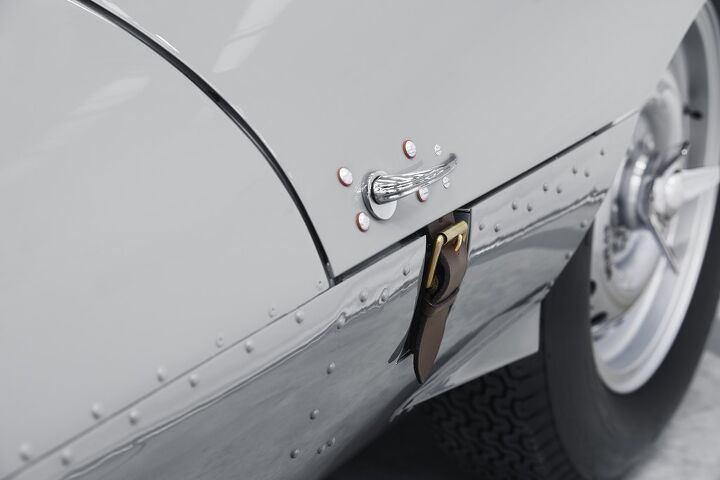Jaguar Engages in Yet Another 'Once-in-a-lifetime Project' With D-Type Roadster Revival

Jaguar has announced the D-Type is re-entering production this week, part of a “once-in-a-lifetime project” designed to get 25 examples of the iconic racer back on the streets. While it’s always exciting to see a venerable model resurface after a six-decade absence, this is nothing new for Jaguar. The company did a limited continuation of the E-Type coupe in 2015, the XKSS in 2016, and a singular electric-powered E-Type prototype in 2017.
That means the “new” D-Type is just another entry in Jaguar Classic’s ultra-premium heritage collection. However, this does not mean the continuation cars aren’t any less cool than a penguin perched atop a glacier adjusting his brand-name sunglasses.
Jaguar assembled the last D-Type in 1956, and the company claims it’s only fulfilling a half-century-old promise to build 100 examples. While the finned roadster represented the absolute pinnacle of automotive development at the time, it lacked the mass appeal of literally any vehicle that wasn’t purpose-built to dominate at Le Mans.
Jaguar says the 25 new examples only serve to complete its 1955 production run, which stopped at 75 units.
“The Jaguar D-type is one of the most iconic and beautiful competition cars of all time, with an outstanding record in the world’s toughest motor races. And it’s just as spectacular today,” said director of Jaguar Land Rover Classics Tim Hannig. “The opportunity to continue the D-type’s success story, by completing its planned production run in Coventry, is one of those once-in-a-lifetime projects that our world-class experts at Jaguar Land Rover Classic are proud to fulfill.”
According to the automaker, every single aspect of the new D-Type will follow original specifications. That includes the usage of the XK6 engines that helped the model win the Le Mans 24-hour race in 1955, 1956 and 1957. How much the owners of these cars will actually get to enjoy the sweet-singing six-cylinder is debatable, though. Since most of Jag’s continuation cars cost in excess of $1 million, most buyers will probably keep them in a garage, under a blanket.
Still, that’s a comparative bargain when you consider original D-Types can cost 20 times that. Sotheby’s currently has a 1954 Jaguar D-Type Works listed for $15 million and previously auctioned a 1955 model for nearly $22 million in 2016.
Buyers have the option to choose either the 1955-specification Shortnose or 1956-spec Longnose D-Type bodywork — in case they’re interested in high-speed stability and that iconic fin. Obviously, Jaguar’s first prototype is the more-flamboyant Longnose model. The automaker said the vehicle will make an appearance at the Salon Retromobile in Paris this week. Deliveries begin later this year.
[Images: Jaguar Land Rover]

A staunch consumer advocate tracking industry trends and regulation. Before joining TTAC, Matt spent a decade working for marketing and research firms based in NYC. Clients included several of the world’s largest automakers, global tire brands, and aftermarket part suppliers. Dissatisfied with the corporate world and resentful of having to wear suits everyday, he pivoted to writing about cars. Since then, that man has become an ardent supporter of the right-to-repair movement, been interviewed on the auto industry by national radio broadcasts, driven more rental cars than anyone ever should, participated in amateur rallying events, and received the requisite minimum training as sanctioned by the SCCA. Handy with a wrench, Matt grew up surrounded by Detroit auto workers and managed to get a pizza delivery job before he was legally eligible. He later found himself driving box trucks through Manhattan, guaranteeing future sympathy for actual truckers. He continues to conduct research pertaining to the automotive sector as an independent contractor and has since moved back to his native Michigan, closer to where the cars are born. A contrarian, Matt claims to prefer understeer — stating that front and all-wheel drive vehicles cater best to his driving style.
More by Matt Posky
Latest Car Reviews
Read moreLatest Product Reviews
Read moreRecent Comments
- SCE to AUX All that lift makes for an easy rollover of your $70k truck.
- SCE to AUX My son cross-shopped the RAV4 and Model Y, then bought the Y. To their surprise, they hated the RAV4.
- SCE to AUX I'm already driving the cheap EV (19 Ioniq EV).$30k MSRP in late 2018, $23k after subsidy at lease (no tax hassle)$549/year insurance$40 in electricity to drive 1000 miles/month66k miles, no range lossAffordable 16" tiresVirtually no maintenance expensesHyundai (for example) has dramatically cut prices on their EVs, so you can get a 361-mile Ioniq 6 in the high 30s right now.But ask me if I'd go to the Subaru brand if one was affordable, and the answer is no.
- David Murilee Martin, These Toyota Vans were absolute garbage. As the labor even basic service cost 400% as much as servicing a VW Vanagon or American minivan. A skilled Toyota tech would take about 2.5 hours just to change the air cleaner. Also they also broke often, as they overheated and warped the engine and boiled the automatic transmission...
- Marcr My wife and I mostly work from home (or use public transit), the kid is grown, and we no longer do road trips of more than 150 miles or so. Our one car mostly gets used for local errands and the occasional airport pickup. The first non-Tesla, non-Mini, non-Fiat, non-Kia/Hyundai, non-GM (I do have my biases) small fun-to-drive hatchback EV with 200+ mile range, instrument display behind the wheel where it belongs and actual knobs for oft-used functions for under $35K will get our money. What we really want is a proper 21st century equivalent of the original Honda Civic. The Volvo EX30 is close and may end up being the compromise choice.





































Comments
Join the conversation
When's Ford going to start offering a ZX2 continuation?
Still love the look of this car - especially that side shot! Thanks for doing up the article, Matt.